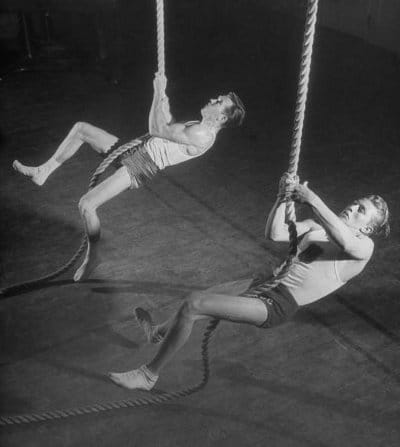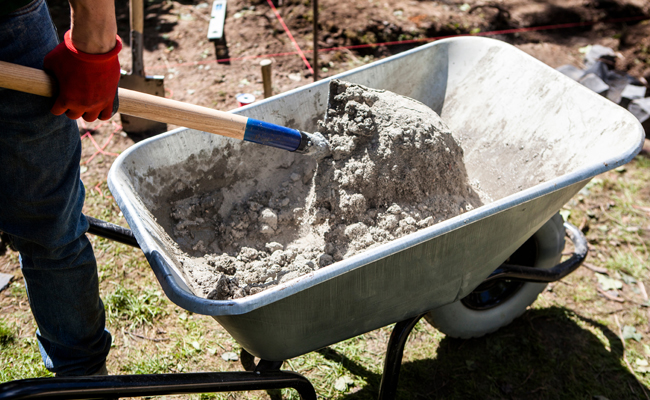
Editor’s Note: This is a guest post from Matt Frazier.
For the past few decades, running hasn’t seemed so cool.
For most guys, the thought of running–not for another sport or because you’re being chased, but for its own sake–conjures up images of high school gym class. Or maybe a skinny guy in short shorts.
But that’s all changing. Runners like ultramarathoner Dean Karnazes are giving distance running a new face, and redefining our image of what a distance runner’s body looks like. Races like the Tough Mudder and Warrior Dash are exploding in popularity, as alternatives to the same old road 5K or half marathon.
Even what we wear on our feet is changing: the barefoot running movement and minimalist barefoot-style shoes like Vibram Fivefingers (regardless of what you may think about how they look) are bringing to the sport hordes of new people who a few years ago would have sooner ripped their toenails out than go for a run.
If you’re one of those new to the sport, or even if you’ve run a bit in the past but never seriously trained for anything, here’s what you need to know to enjoy it and keep from getting injured.
Why So Many People Hate Running, And How to Fix It
I have a theory about why so many people tell themselves (and often others) that while running a marathon sounds nice in theory, they just don’t like running enough. Or, more frankly, they hate it.
Remember the mile run that we all had to do in gym class? One day, instead of playing dodgeball or floor hockey or something else cool, they’d make us run. And not just for fun, but as fast as we could. Our times were recorded, and if you were the 10-minute miler in the class or simply the slowest of your friends, you were laughed at.
In this way, we learned to run. Go as hard as you can for a mile. It’ll hurt, you’ll probably cough a lot and maybe even taste blood in the back of your throat. But in a few minutes it’ll be done, and we won’t have to do it again until next year.
If this is running, is it any wonder so many of us associate it with pain?
So here’s the secret about distance running that people who think they hate it don’t know: running a marathon isn’t 26.2-times harder than that mile in gym class was.
Why? Because nobody could possibly keep up their gym-class mile intensity for 25 more miles. To run a marathon, or even a half, everything must change–from your mindset to your form. Here’s how to run (and think) like a marathoner.
Run Slower
Who made the rule that every run has to be done as fast as possible?
Think about it: if the farthest you’ve ever run is a 5K, how much longer might you be able to go if you slowed your pace way down–say, from a 7:30 pace to a 9-minute mile?
Next time you go for a run, try it. If you normally run an eight-minute mile on the treadmill at the end of your strength training workout, change it up. Go outside, take 10 minutes to run that mile instead of eight, and actually try to enjoy it.
Running slow isn’t just an exercise to help you learn not to hate it; slow miles have their place even in serious training programs. If you’re training for your first marathon or half, for example, most of your long runs should be done at one to two minutes slower per mile than you’re capable of running the distance on that day. Any faster than that when you’re trying to run 10 or 15 miles for the first time is just begging for an injury.
So step one is to slow down. But what about form?
As it turns out, there’s a simple trick that helps everything fall into place.
Injury-Proof Your Stride with One Simple Trick
The key to drastically lowering the stress running puts on your body is to take more steps. Just like running slower, this one isn’t just a form of training wheels; it’s a habit practiced by the best marathoners and ultrarunners in the world.
If you were to look at the cadence of most elite runners–that is, the rate at which they take strides–you’d find that nearly all of them take at least 180 steps per minute. Compare that to your average weekend warrior’s stride rate, and you’ll find that the elites are taking about 30 more steps each minute than the amateur.
Why take more strides each minute? Because taking short, quick steps, as opposed to long, slow ones, means your feet spend less time in contact with the ground and create smaller impacts with each contact.
Better still, turning your feet over this quickly requires that you keep your feet under your body and land on your midfoot. Compare this with what you see most runners doing at the local 5K: crashing down on their heel with their leg way out in front of them on each step. This small change alone will go a long way toward preventing the injuries that so many people associate with distance running.
(Bonus: part of the rationale behind the barefoot running craze is that without a big cushioned sole to protect your foot, it’s actually very painful to take gigantic steps and to land on your heel. So running without shoes “automatically” improves your form, by forcing you to take smaller, lighter steps and land on your midfoot. But don’t fret if you don’t want to go barefoot–you can get many of those same benefits with shoes on, if you simply focus on increasing your stride rate.)
So how do you actually train yourself to take quicker steps? It’s easiest to think of 180 steps per minute as three per second, and then lock in with that rhythm as you stare at a ticking clock. Of course, this is far safer and easier on a treadmill. Don’t try this with your watch out on the roads.
Another way is to run to a metronome, or better yet, to find a song whose tempo is such that you can line your steps up with it to hit three each second.
It’ll feel like the most awkward thing in the world at first, I promise. You’ll feel like a cartoon character, spinning your wheels without actually covering much ground.
But give it time. You’re working different muscles than any running you’ve done before has used, so it’ll take some getting used to. But after several runs like this, it’ll start to feel normal, and you’ll be far less likely to get injured than before.
Alternate Hard Workouts with Easy Ones
You could do nothing but slow runs and become a marathoner. In fact, a lot of people do just that when they first train for a marathon or half. With every step you take, even at a slow pace, your body learns to run more efficiently and your endurance improves.
But if you’re in it not just for the satisfaction of running far, but to gain fitness or for the thrill of training to beat a certain time, then you’ve got to do some harder workouts so that your body can make adaptations and become stronger. (Besides, running at just one speed can get pretty boring.)
So when you’re ready to start mixing it up, you’ll want to consider two other types of training: speedwork and threshold training.
Speedwork
Speed workouts are what they sound like. The goal is to run at a much faster pace than you could maintain for any significant distance, but to break up these bouts of intensity with rest intervals. Speedwork is generally done on a track, so that the terrain is consistent and flat, and so that you can easily gauge your pace with a glance at your watch and the markings on the track that tell you how far you’ve gone.
Here’s a simple speed workout to try, once you’re comfortable with running a few miles: run half a mile (800 meters) at a pretty good pace, about the pace you could maintain for a mile or so. Time how long it takes you do it, then rest for that same amount of time by lightly jogging or even walking. Repeat four times, or for as long as you find that you’re completely recovering during the rest interval. These intervals are known as Yasso 800’s, after Bart Yasso, the coach who invented the workout.
Speedwork is tough, and it’s something you’ll probably want to do only once a week at first. The next type of workout is slightly less intense, but longer in duration.
Threshold training
Your anaerobic threshold is the intensity at which your body transitions between a comfortable aerobic state (where your easy runs should be) and the more demanding, oxygen-consuming state you’d call upon in a fight-or-flight situation. Threshold training teaches your body to increase the intensity at which your body transitions–in short, it trains you to stay in “comfortable” mode longer and at higher speeds.
Threshold training is often described as “comfortably difficult:” it should be an intensity that you can maintain for about 45 minutes, and no longer. If you’ve run a 5K recently, try a slightly slower per-mile pace than that one for your threshold training. You should be able to speak in short sentences, but getting a whole paragraph out should be tough. (As an example, if you can run a 5K in 25 minutes, try a threshold pace of around 8:30 per mile.)
Start with twenty minutes or so at that pace, and build from there to run faster and longer as your fitness improves. You can work in some hills, or even do this run on a trail to keep it interesting, but you’ll have to slow your goal pace to account for the rougher terrain.
The Long Run
The bread and butter of a distance runner’s regimen is the long run. It’s the longest workout of the week, and if you’re training for your first half or full marathon, this is where you’ll often run farther than you’ve ever run up to that point.
The long run isn’t complicated–essentially, you run at an “easy” pace, one that’s slow enough that you could easily carry on a conversation throughout the run. The long run is the one where you’ll need to make stops for water and nutrition (or bring it along with you), as described below.
The hardest thing about the long run, in my experience, is the monotony. If you find that you get bored, you can break it up by bringing along an iPod loaded with a playlist or even an audiobook. Or if you’re the outdoorsy type, you’ll find that trail running offers an escape from the busy world and a chance to meditate, think, or just relax while you run.
How to Fuel While You Run
A common mistake new runners make, and I was no exception when I trained for my first marathon, is sabotaging your workouts by failing to fuel properly. Where so many new runners mess up is in failing to realize that the food they eat before and during their runs has a major impact on how they feel and perform. Here’s how you can get it right.
Before your workout
Prior to all but your easiest, shortest runs, you’ll want to take in a fair amount of carbohydrates, and if possible, a little bit of protein. A 3:1 ratio of carbohydrates to protein is a good one to shoot for, but don’t worry about being precise. Avoid fat and fiber, as they’ll increase the chances of stomach issues, which–trust me–are nobody’s friend when you’re five miles into a trail run.
And the longer you have until your workout, the more you should be eating in this pre-run meal. If you’ve got two hours or more before you run, you might try a bagel with peanut butter and a piece of fruit. If your workout is in an hour, go smaller: I like a small glass of orange juice with a little bit of protein powder mixed in. And if you’ve got to head out the door to run as soon as you eat, try a handful of dates. The glucose will get into your bloodstream quickly and you’ll be able to use it as soon as 15 minutes later.
During your workout
Obviously, you’ll need water. Three or four cups of water per hour is a safe range, but of course the actual amount you need will vary widely with intensity, heat, and humidity.
For runs of less than an hour, you probably won’t need to eat anything during the actual workout, as long as you’ve eaten something in advance. Most people store enough glycogen to run for about an hour and a half before their body shuts down to protect the brain, so eating on anything over an hour is a safe rule of thumb.
If you’ll be out more than an hour (or if you’re running really hard for a shorter period of time), aim for 30-60 grams of carbohydrate per hour of exercise to keep your glycogen stores up, depending on your size and the intensity of your run. And be sure to replace electrolytes, which you lose as you sweat, and which are needed to safely balance the water you’re taking in. A sports drink or energy gel is a good way to get both calories and electrolytes from a convenient source, but most substantial foods like fruits and energy bars tend to be more appealing once you’re sick of sports drinks and gels on very long runs.
After your workout
How you eat after your run, especially during the crucial few minutes immediately afterward known as the recovery window, is just as important as the quality of your workout for helping your body to adapt and increase strength and speed.
Within the first half hour or so after you’re finished with your run, eat a good-sized meal of carbohydrates and protein, in a roughly 4:1 or 5:1 ratio of carbs to protein. You may have heard the phrase “earning your carbs,” and it’s true here: the hour immediately after a workout is the one time of day when all those carbohydrates you’re not supposed to eat–white rice, white pasta, and even sugar–are highly beneficial. So enjoy this time, and think of it as your reward for working hard out there.
Putting It All Together
You wouldn’t go the gym and do the bench press every day, right? You know that muscles need to recover, so you give each muscle group a chance to rest after a hard workout.
It’s the same with running. You’ve got to give your body time to recover if you want it to improve. When you’re just starting out, treat your hard runs (speedwork, threshold, or long run) as your workouts, and make sure that between every workout you take it easy. Either take a day off, go for a really easy run at conversational pace, or do some light cross-training.
Week to week, this is all well and good. But if you’re training for a long race, you want a map that dictates how you should increase you mileage over time as you build up to the distance you’re training for, as well as a nutrition plan to make sure you’re getting the calories you need to keep your body going.
So find a plan to get you where you want to go. It’s not hard to find free training plans online, but you’re better off shopping around to find a book or plan that’s right for you. Training for a long race is a big commitment, and it’s worth doing it right.
To go farther with the information in this post and for some training plans I like, check out these resources for getting started (or getting serious) with distance running:
- Daniels Running Formula – an excellent primer to scientific training, complete with training programs for several popular distance and ability levels.
- Run Less, Run Faster – a novel approach to improving your speed and minimizing the time you spend running, by replacing easy, “junk” mileage with cross-training.
Remember the wise words of Lao-tzu: The journey of a thousand miles starts with a single step. Don’t be discouraged if you can only run for three or four minutes without stopping right now. In that case, make five minutes your goal. Once you reach it, work towards 10.
Learning to run farther than most people drive in a day isn’t the result of crazy-intense workouts or an unnatural gluttony for punishment (ok, maybe that one helps on race day). Instead, it’s the result of consistent, small steps. Get out there day after day, challenge yourself a little bit each time, and you can’t help but become stronger, faster, and more durable.
Happy running!
Listen to our podcast on the myths and truths of distance running:
__________________________
Matt Frazier is a marathoner and ultramarathoner, and he’d probably be a triathlete if he weren’t such a terrible swimmer. Matt helps runners and other athletes train and eat better with his blog, No Meat Athlete, where he offers a free e-course on plant based nutrition for endurance.
Tags: Sports






